Question of the Month
December 2009 - January 2010
Why do I advocate Manual Exposure so avidly?
On our recent trip to Antarctica and South Georgia and the Falklands, most of the 70+ photographers on board shot some version of an automatic mode. Some of the most serious photographers, and ones that I felt consistently produced great images, photographed on Manual Mode, exactly as Mary and I do. Most of the other leaders did in fact shoot on Aperture Priority Mode, but in tricky situations most of those also switched to Manual Mode and they could ...
because they knew how!
Automatic exposure modes, especially Aperture Priority, and Evaluative or Matrix Metering truly does work well most of the time, but as photographers discovered on this trip, when they were trying to shoot flying seabirds that alternated between being framed against the sky and the sea, and in high contrast situations involving icebergs or middle tone subjects against black, shadowed cliffs, these modes often failed.
I often find myself in these situations gently arguing on the merits of using manual mode, and those proponents are so convinced that I sometimes worry that my conviction might indeed be old school and antiquated, and I'm missing the boat in not shooting in Aperture Priority. So I almost always test myself, composing on a challenging subject that I know Manual Mode will handle correctly but may, just may, defeat an automatic mode.
On our first day at New Island in the Falklands, I had the right conditions to test this on our first day ashore. Here's the shots:
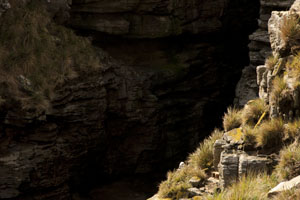
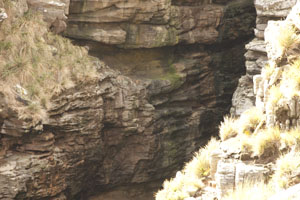
On the left, my Manual exposure, with the black cliff face still dark and in deep shadow. On the right, my Aperture Priority exposure, which made the black cliff a 'gray' cliff, but also overexposed the right side of the image, which was in sunlight.
Now, if you know your digital photography, you know that a histogram should be pushed to the right to capture the most data. While an image may look overexposed when you do this, work in the RAW converter can pull back the exposure so that it looks correct. I've done that to the best I could with the Aperture Priority image on the right, as you'll see below:
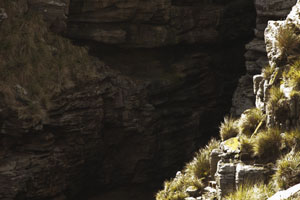
Doing so, I've darkened the cliff almost to the same tonality as I had in the Manual Mode image, but I can assure you that there is much less noise in the black area. However, look carefully at the sunlit area on the right. The color is different, and the highlights are still white, they are still clipped, and the detail there is lost. Here's the histogram from the image, as captured in Photoshop:

While it may not be clear, the area on the right is clipped and if you look carefully you will see the 'sneaky peak' that shows that all detail here is lost. In this case, it's quite clear that Manual Mode did the better job, but this example also illustrates why it may be a bit imprudent to always overexpose (as some experts suggest) to maximize data capture and to then 'normalize' the image with the RAW converter you are using.
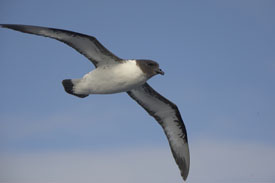
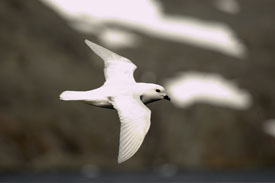
I referred to the seabirds we photographed, and here is two examples. Mary shot this Cape Petrel on Manual Mode, and while she worked these birds they flew against the sky and also against the sea. By setting her exposure manually, she had the correct exposure for THE BIRD, regardless of what the background was. She did the same thing for the Snow Petrel, a subject that could really trick a meter. I can only speculate what an automatic metering mode would do when this white bird was framed against a solid black background (like a shaded cliff) or against a bright white glacier. On manual, Mary didn't have to worry.
In advocating this, I'm not saying that an automatic metering mode doesn't work. It does, most of the time, and many will argue that it saves them valuable shooting time by allowing them to concentrate on framing and composition and not on exposure. Of course, when I ask them what they'll do when a subject like the snow petrel presents a challenge, they seem to squirm or shrug. My point is, Manual Mode works, and the best photographers I know, even if they usually use Aperture Priority, do in fact know how to meter manually, and do so when the circumstances require it. And you should know how, too.
If Manual Metering and Spot-Metering Mode is a mystery to you, consider taking our Digital Complete Nature Photography Course, in either Arizona or in Pennsylvania, and learn the craft of photography. Observing some of the shooters on my last trip, I fear this craft is becoming something of a lost art. I'd love to change that!
On a final note, many of the more serious photographers on the trip expressed an interest in understanding manual metering for making an exposure. Most were using Aperture Priority, which works wonderfully much of the time. But it fails in contrasty situations, like black cliffs forming a background for middle-tone subjects, or seabirds bouncing between bright, overcast skies and dark, turbulent seas. In those times, Aperture Priority may overexpose (black backgrounds) or underexpose (bright sky backgrounds), where Manual Mode, if done correctly, would provide a consistently accurate exposure. You can learn how to become a master of Manual Exposure, as well as a wealth of other vital photographic and digital skills, at our Digital Complete Nature Photo Course, held in both Arizona and in Pennsylvania.
Questions of the Month
Where can I find Depth of Field reference charts?
What is the Kiboko backpack? Is it the New Best Pack?
Is there a correct position for the upright on a Wimberley actionhead?
How, Who, and Why? The story behind our new web site.
Archived Questions of the Month
Most of my original Questions of the Month for the last several
years are available through this link. The 'look' is from my
original web site, although if I ever have enough time I might
redo these pages to match the new web site But that's not
a high priority.


